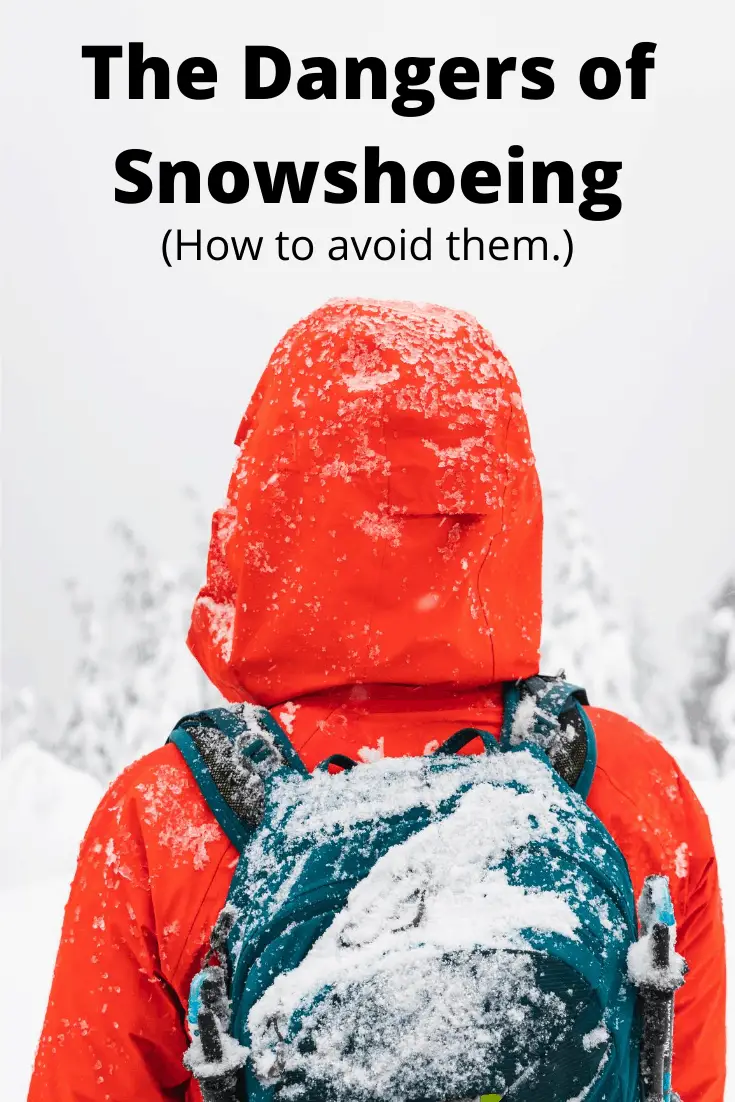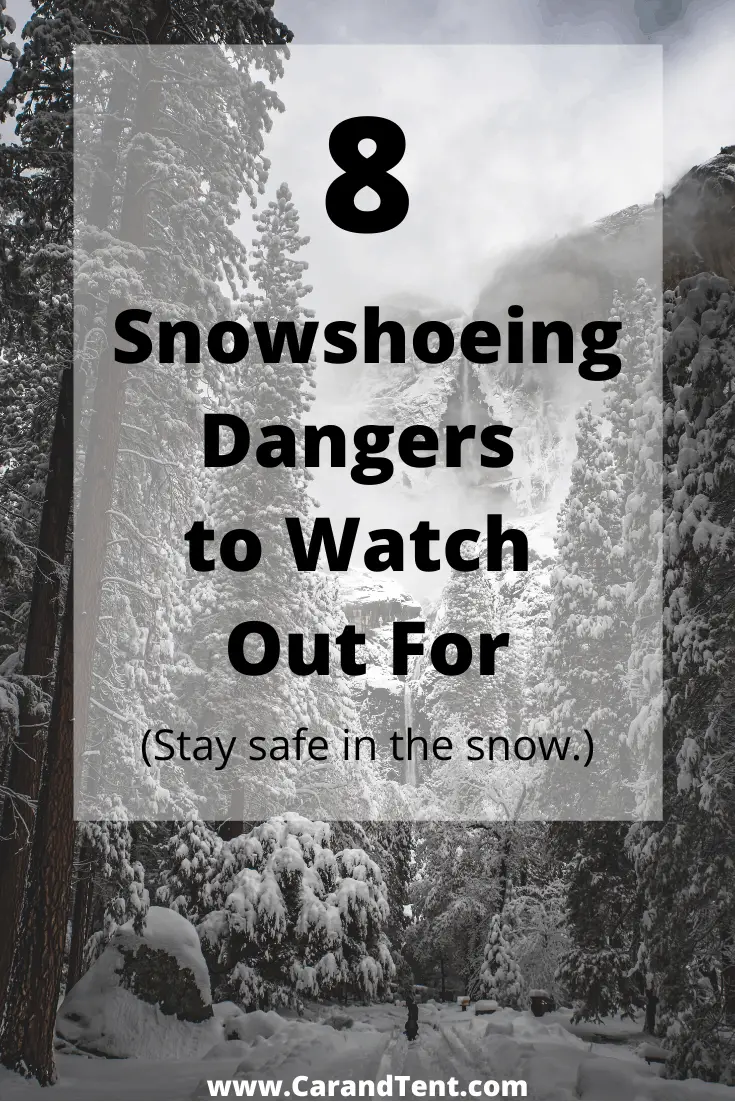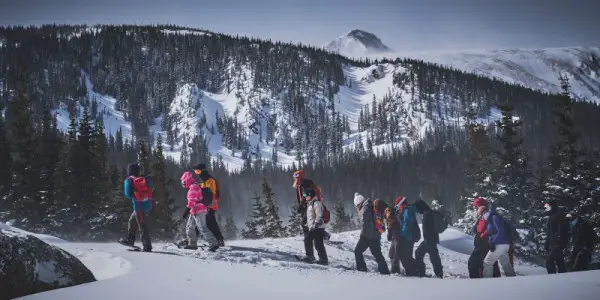
Snowshoeing is a great workout and a lot of fun. It’s also easy to get into as it doesn’t require a ton of skill or a lot of gear.
But, is snowshoeing dangerous? Snowshoeing, just like most outdoor activities, can be dangerous. A person can get lost on the trail, they can get hurt in the snow, and a whole host of other dangerous situations can arise while a person is snowshoeing.
To stay safe while snowshoeing, you’ll have to take some precautions. In this post, I’ll give you a rundown on the dangers of snowshoeing and give you some tips on how to avoid them and how to deal with them when you can’t avoid them.
Table of Contents
The Dangers of Snowshoeing
Snowshoeing doesn’t bring a lot of dangers with it, but the ones it does bring can be deadly.
Here are some of the dangers you may run into when snowshoeing:
- You could suffer from snow blindness.
- You could get sun poisoning.
- An avalanche could bury you.
- A fall could disable or kill you.
- The cold weather could kill or permanently injure you.
- You could drown.
- It could be easy to get lost.
- You could suffer from health issues.
1. Snow Blindness
Overexposure to ultraviolet rays can lead to your cornea becoming sunburned. This is known as snow blindness.
Snow blindness can lead to blurry vision, eye pain, headaches, and even a complete loss in vision. This vision loss is usually only temporary but it can be extremely dangerous for those of us who are out on a snowshoe trail when it happens.
Technically, your corneas can become sunburned at any time but it is much more likely to occur in the snow. The reason for this is that snow is highly reflective so you end up getting hit by UV light from all around you.
On the positive side, snow blindness is incredibly easy to protect against. Wear a pair of sunglasses or a pair os snow goggles and you shouldn’t have to worry about the snow or the sun damaging your eyes.
2. Sun Poisoning
Now that you have your snow goggles, you should know that the sun can do more than hurt your eyes. In the winter, the sun sits lower in the sky and it can cause damage to your skin much more quickly than in the summer. As a result, your exposed face can become a victim of sun poisoning.
Once again, you have an easy solution to this problem. Wear sunscreen on your face and cover it with a balaclava when the cold weather calls for it. Choose a thick sunscreen and it will help protect you from the wind as well.
3. Avalanches
Depending on your location, you may have to worry about avalanches. Avalanches can occur anywhere, but they typically occur on slopes of 30 degrees or more. The avalanche damage isn’t limited just to the slopes either.
An avalanche will travel down a slope and will continue to move until it runs out of momentum. What this means is that you could be on flat ground and you could still be hit by an avalanche.
What’s worse is that there are a few ways in which an avalanche could injure or kill you. For starters, you could be hurt by the falling snow and ice. Also, the avalanche could sweep you right off of a mountain or into a river.
Even if the avalanche doesn’t move you very far, it could end up burying you. Fail to get yourself out of the snow and you could suffocate or even freeze to death. Even if you manage to climb out of the snow on your own, you might find that you don’t know where you are anymore.
So what can you do about avalanches when snowshoeing?
In case you were wondering, you can’t outrun an avalanche. Avalanches can travel as fast as 120 miles per hour and they can go right over or even through trees, rocks, and buildings.
The best thing to do is to avoid areas that are prone to avalanches. You can do this by taking classes and educating yourself on avalanches, or you could simply choose a completely flat area to go snowshoeing in. If you’re unsure about the area, you could also ask a local ranger or outdoor guide.
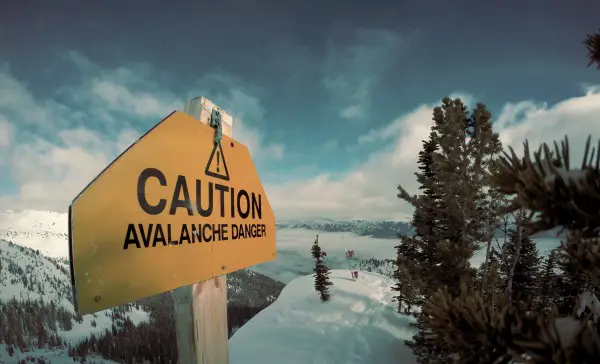
Sometimes, you just need to read a sign.
If you want some additional protection against avalanches, you may want to consider getting an avalanche transceiver. These devices will help others find you so that they can help get you out once you’re buried.
Of course, none of this will matter if you suffocate right away. To avoid this, quickly dig a breathing space for yourself before the snow settles. Provide room not only for your mouth but for your chest as well. This will keep your lungs from being crushed too far in for you to breath.
Once you’ve done this, you can try to call for help and then begin the task of trying to get yourself out. Again, in many cases, this will be an impossible task so you’re really better off avoiding avalanche areas in general.
4. Falls
Even with snowshoes on, you won’t always float over the top of powdery snow. Not only this, but you won’t always know how deep the snow is.
Unfortunately, this may lead you to think that some areas are safe to walk on when they’re not. You could end up stepping in what you think is a small pile of snow, only to end up falling through and off of a ravine or cliff.
Avoid these types of falls by staying on the trail. Also, try to go to places that you’ve been before the snow started falling so that you’ll have a better idea of what the terrain is actually like.
Another thought to keep in mind is that you could also end up falling down rather than off of anything. This could lead to broken bones, sprains, and even a concussion.
The best way to avoid this is to bring snowshoe poles and to proceed with caution. Also, don’t walk backward in snowshoes as you’ll just end up tripping over your own feet.
5. Cold Weather
You can’t have snow without the cold weather. Regrettably, this means you can’t go snowshoeing without running the risk of frostbite and hypothermia.
The best way to avoid these issues is to dress appropriately. For a detailed guide on how to do this, see my post on what to wear snowshoeing.
6. Drowning
Another danger that many beginner snowshoers don’t often consider is the fact that snow can easily hide ice-covered lakes, streams, and rivers. Unfortunately, this ice isn’t always strong enough to hold the weight of a person.
As a result, a snowshoer could accidentally find themselves deep in a frozen lake or river. The end result could be that the person drowns or gets themselves out, only to die of hypothermia shortly afterward.
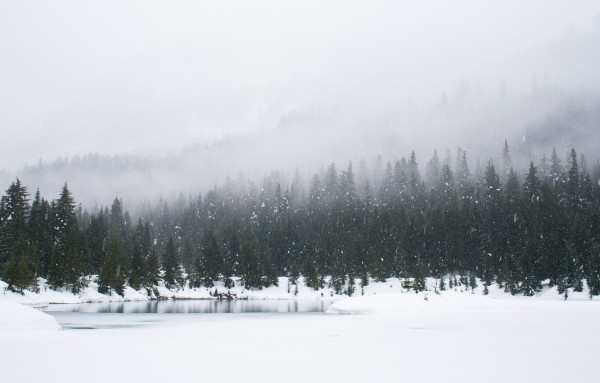
Once again, the best way to avoid this is to stay away from these issues completely. Only travel through trails that do not run close to lakes and rivers that could accidentally be walked over. If you’re unsure of the area, get yourself a map and study it in advance. A little bit of caution and some extra planning could easily save your life.
7. Disorientation
Hiking trails can quickly become covered with heavy snowfall. This makes the trail harder to identify and harder to stay on. Combine this with the fact that everything looks different in the snow and it’s easy to see how a person could become lost while snowshoeing.
Once you’re lost, you run the risk of staying in the backcountry for too long. This increases your chances of dying from exposure and dehydration.
There are two things you should do to help protect yourself from getting lost while snowshoeing.
The first step is to learn all you can about the area. Bring a map and a compass to help you find you’re way out if you do get lost.
The next step you can take is to make sure you always have emergency supplies with you. Always have enough gear, water, and food with you that you could potentially stay out overnight if you had to.
This might include packing extra food, extra water, extra clothing, and an emergency blanket, an emergency sleeping bag, or an emergency tent. If you don’t mind carrying the extra weight, you could even bring a backpacking tent and sleeping bag along with you for additional warmth.
8. Health Issues
Cardiologists caution heart attack victims and people with heart issues not to shovel snow in the winter. Unfortunately, many people do anyway and they end up dying as a result.
The reason for this is that cold weather puts additional stress on a person’s heart and lungs. This additional stress, when combined with vigorous exercise like shoveling snow can be too much for some people.
Snowshoeing can often be even more physically challenging than snow shoveling. Because of this, you may want to get clearance from your physician before you hit the snowshoe trails this year.
Final Thoughts
Snowshoeing does come with dangers. However, if you plan ahead and carefully choose the safest trails, you can easily avoid most of these dangers.
